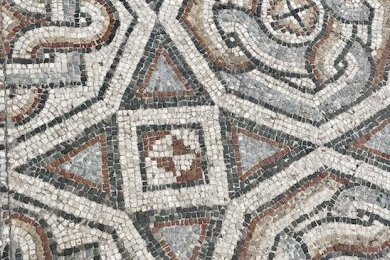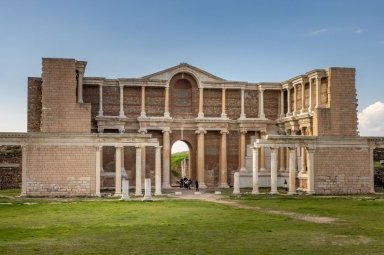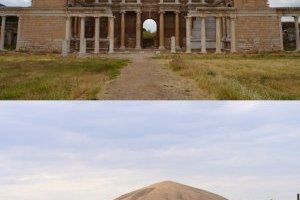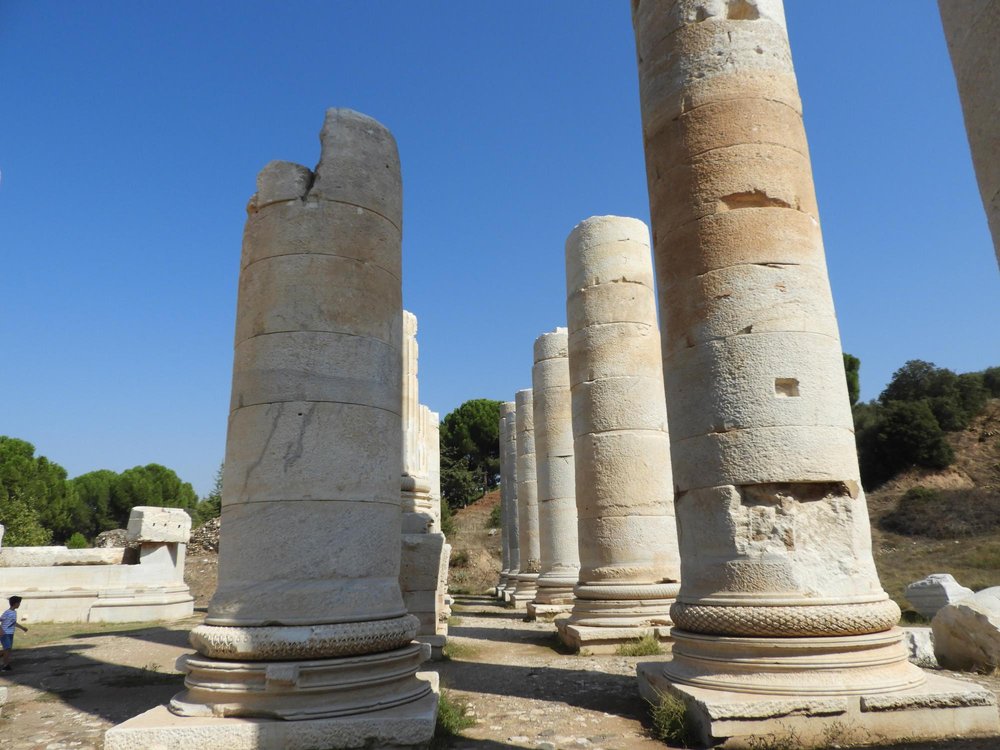Turkiye
Sardis
Sardis and the Lydian Tumuli of Bin Tepe testify to the ancient civilization of the Lydians and their King Croesus. Sardis was the capital of the kingdom of Lydia and a major city during the Iron Age. It was the first place where pure silver and gold coins, the value of which could be trusted, was minted. The terraced city had a distinctive urban plan and architecture. The nearby Lydian tumulus cemetery at Bin Tepe holds some of the largest tumuli in the world.
Community Perspective: What can be visited today at Sardis mainly dates from the (significantly later) Hellenistic and late Roman periods. The second location Bin Tepe is more rewarding if you’re looking for pure Lydian remains.
Site Info
Official Information
- Full Name
- Sardis and the Lydian Tumuli of Bin Tepe (ID: 5829)
- Country
- Turkiye
- Status
-
Nominated 2025
Site history
History of Sardis
- 2013: Added to Tentative List
- Added to tentative list
- Criteria
- iii
Links
- UNESCO
- whc.unesco.org
All Links
UNESCO.org
- whc.unesco.org — whc.unesco.org
Community Information
- Community Category
- Natural landscape: Rivers, Wetlands and Lakes
- Religious structure: Buddhist
- Archaeological site: Classical (other)
Travel Information
Izmir Hotspot
Recent Connections
-
Seleucid Empire
"In 282 B.C., the city became a Seleuci… -
Hellenistic Greece
After Alexander the Great conquered Sar… -
Ancient Anatolian cultures
Lydians
Connections of Sardis
- Individual People
-
-
Alexander the Great
Sardis was conquered by Alexander the Great in 334 BCE. Alexander personally accepted the surrender of Sardis
-
- History
-
-
Seleucid Empire
"In 282 B.C., the city became a Seleucid capital, during which time it acquired status as a Greek city-state." -
Byzantine Empire and Civilization
Sardis remained in the Byzantine Empire until 1306, when it was handed over to the Ottomans as part of a treaty. -
Located in a Former Capital
Sardis was the capital of the Lydian Kingdom -
Mongol Invasions
Sardis was destroyed by the Mongols in the 15th century -
Ottoman Empire
Sardis was part of the Ottoman Empire between the handover by the Byzantine Empire and its destruction by the Mongols -
Ancient Anatolian cultures
Lydians -
Hellenistic Greece
After Alexander the Great conquered Sardis in 334 BCE, the city underwent a significant transformation into a "true Hellenistic city." During the Hellenistic period (following Alexander's death), it gained the status of a Greek city-state and saw the construction of major Greek-style public buildings
-
- Religion and Belief
-
-
Jewish religion and culture
Sardis had a significant Jewish enclave with a massive Synagogue, of which the remains are still present
-
- Human Activity
-
-
Mints
Sardis is considered to be the birthplace of modern currency. 650 BCE the Lydians started to mint gold and silver coins.The minting tradition lasted until the reign of Roman emperor Gallenius (253-268).
-
- Constructions
-
-
Tumuli
several Tumuli in Bin Tepe, as burial places for the Lydian kings -
Acropolis
About 1km from Sardis. Includes the temple of Artemis. -
Dynastic Burial Places
Bin Tepe is the burial place of the Lydian kings
-
- Timeline
-
-
Built in the 7th century BC
While there was a settlement as early as 1500 BCE, Sardis became capital of Lydia in the 7th century BC
-
- WHS Hotspots
-
-
Izmir Hotspot
There are some infrequent direct buses to village Sart (1.15 min) or more frequent buses to Salihli (1.20 min) and local dolmus from Salihli to Sart (15 min)
-
News
No news.
Community Reviews
Show full reviews
Sardis was a great change of pace from the tourist-filled Ephesus and Pamukkale. The gymnasium alone is very impressive, and has a somewhat different visual weight to it from the other ancient sites in the region -- more red brick than white marble, for instance -- and it's much less crowded. The synagogue is the largest known synagogue from the ancient world. The mosaics throughout the WHS are also nice. A pet peeve of mine is ruins without any signage, but Sardis doesn't disappoint in this matter either; there is plenty of signage in Turkish & English to explain what you are seeing with out it being overbearing.
In terms of the negatives, the "museum" on site is very small and had actual spiderwebs across it when I attempted to enter. Some of the artifacts and mosaics are replicas, with the originals being hosted in various museums. Bintepe, the other component, can't really be entered but you can see it from the highway when you are driving to Izmir (at least I think I saw it!). The only part of Sardis I didn't see was the Temple of Artemis. As the former capital of the Lydian Empire, it was an interesting sight to see, and I would recommend to travelers already in the area :)
Keep reading 0 comments
Sardis is nominated for 2025 inscription. I think it should be as there isn't much Lydia related material on the list and the city played a key role and of course, coinage was "invented" there and without it I would be without a job today.
Sardis, an ancient city of great historical significance, was renowned for its wealth and cultural achievements. As the capital of the Lydian Kingdom, it thrived as a center of trade and innovation. Notably, it was where coinage was first minted, revolutionizing commerce. Sardis played a pivotal role in the Persian Wars, falling to Cyrus the Great in 546 BCE. Later, it became part of the Hellenistic world under Alexander the Great’s conquests and eventually came under Roman rule.
The site is small with just the gymnasium and synagogue and some baths, walls, and other smaller buildings left. The synagogue has a beautiful mosaic floor. It’s quite impressive. The gymnasium has its full facade left with lots of sculptures and bas reliefs. I really enjoyed the state of it and just this facade is worth visiting. Nearby is another Temple of Artemis (not sure if this will be part of the WHS) which is worth a stop for 30 minutes as well. I did not have time to visit the Tumuli.
I visited Sardis after my morning visit to Ephesus and ended the day in Izmir. Quite a long very long day. I would recommend doing it different. Visit half day Sardis and …
Keep reading 0 comments
Ancient Sardis is best known for Croesus, the last king of Lydia, and his legendary wealth. Already in ancient times, Lydia was associated with immense wealth. Whether King Croesus was really the richest man of his time has not been proven. Perhaps this attribute is rather a symbol for the introduction of gold coins, which is attributed to the Lydians. The supposedly oldest gold coin was found during excavations in Sardis. But if you visit Sardis to find traces of its former glory, you may be disappointed. The present-day town of Sart does not exude any flair of pomp and wealth.
Ancient Sardis and the Tumuli of Bin Tepe are nominated for decision in 2025. And I guess that an inscription is verly likely. Among the numerous archaeological sites still waiting on the Turkish tentative list, Sardis has probably the greatest historical significance.
Sardis was the capital of the Lydian Empire until the Persian conquest in the 6th century BCE. Located on the trade route from the Aegean coast to the interior of Asia Minor, today's Anatolia, Sardis was an important centre of trade and commerce. And its significance and prosperity continued even after the fall of the Lydian Empire, when Sardis was under Persian, Hellenistic and Roman rule.
Today Sardis is a little off the main tourist route that leads visitors from Pergamon via Ephesus to Aphrodisias and Hierapolis. Certainly, because the visible remains are less impressive compared to the already inscribed archaeological sites in western Turkiye. …
Keep reading 0 comments
